Roam's Impressive Start and How to Find Its Next Phase of Growth
Alfred Lua / Written on 17 April 2020
Hello,
We are all still going through a tough time, and I wanted to ask, "how are you doing? How is your business doing?"
At Buffer, we saw a dip across all our marketing metrics (pageviews and signups) in March. They seem to have recovered to a new baseline now. Here are some | more details that Kevan Lee, our VP of Marketing, have shared on this.
On to this week's update:
Roam-ing around for note-taking apps
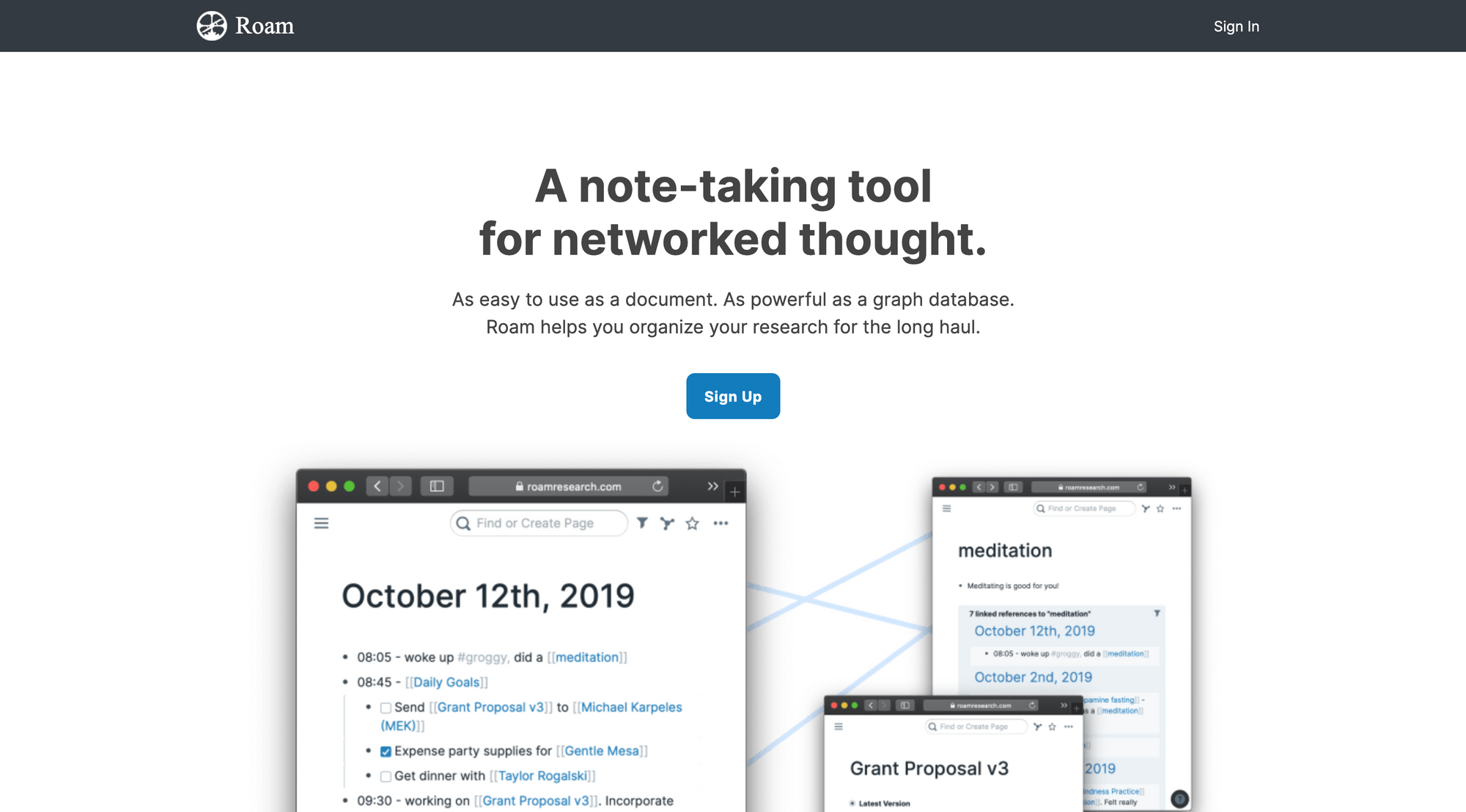 "Well, this is ugly."
"Well, this is ugly."
That's my first impression when I discovered Roam. At that time, I simply thought it was a note-taking app for researchers. The web app has a black sidebar and a white space in the middle for taking notes in bullet points. It didn't, and still doesn't, have a mobile app.
I left.
A few weeks later, as I was building an app and learning about React, I decided to take notes lest I forget what I've read. "Hmm, that Roam app, maybe I'll give it a try," I thought. I quite like taking notes in bullet points because I feel like I'm not forced to write in full sentences. But Roam uses markdown, which I'm not used to. And there's no proper organization of my notes. I struggled to see myself using it regularly. And I didn't.
Somehow, suddenly, Roam kept appearing on my Twitter timeline. Some people I follow were raving about Roam. How good can this app be? I tried and gave up twice! Last weekend, I devoted a few hours to properly learn how to use Roam.
I became hooked.
I use it every day now.
Increasing friction to drive distribution
One of the most common advice about growing a product is to reduce friction. Reduce the number of fields on your signup form. Make your app easy to use. Create a simple checkout flow.
Roam does the opposite of that.
I signed for early access and had to wait for a welcome email before I could create an account. Now, it seems you have to pay $99 for early access.
The app has such a steep learning curve that I gave up twice. Despite having spent hours every day using it for the past week, I don't think I have learned how to use it to the full potential yet. And it isn't just me. There is a Slack community and subreddit where people are sharing the new things they discovered in Roam.
The checkout flow? When I started using it, it doesn't even have a price. To me, that is a sign that the software is still in its early stage and it may or may not become a full-fledge product eventually.
Yet I poured all my notes into Roam. A commitment that feels more significant than paying a fee every month. And many others did that, too. I couldn't find how many users they have (I estimate to be in the thousands) but that is besides the point.
Roam has a super engaged early user base, and I don't use "super" lightly.
Nat Eliason, an early Roam user, created a $99 course on using Roam, which has generated more than $50,000! (Roam has only been available for four months.) More than 500 people have paid $99 to learn how to use an app. Yes, learn how to use the app, not pay for the app.
Francis Miller, another early Roam user, set up RoamBrain.com to compile all the guides and content about Roam.
There are hundreds of videos about Roam on YouTube, with at least 100,000 views, according to my rough estimation. I gave up counting after the first page.
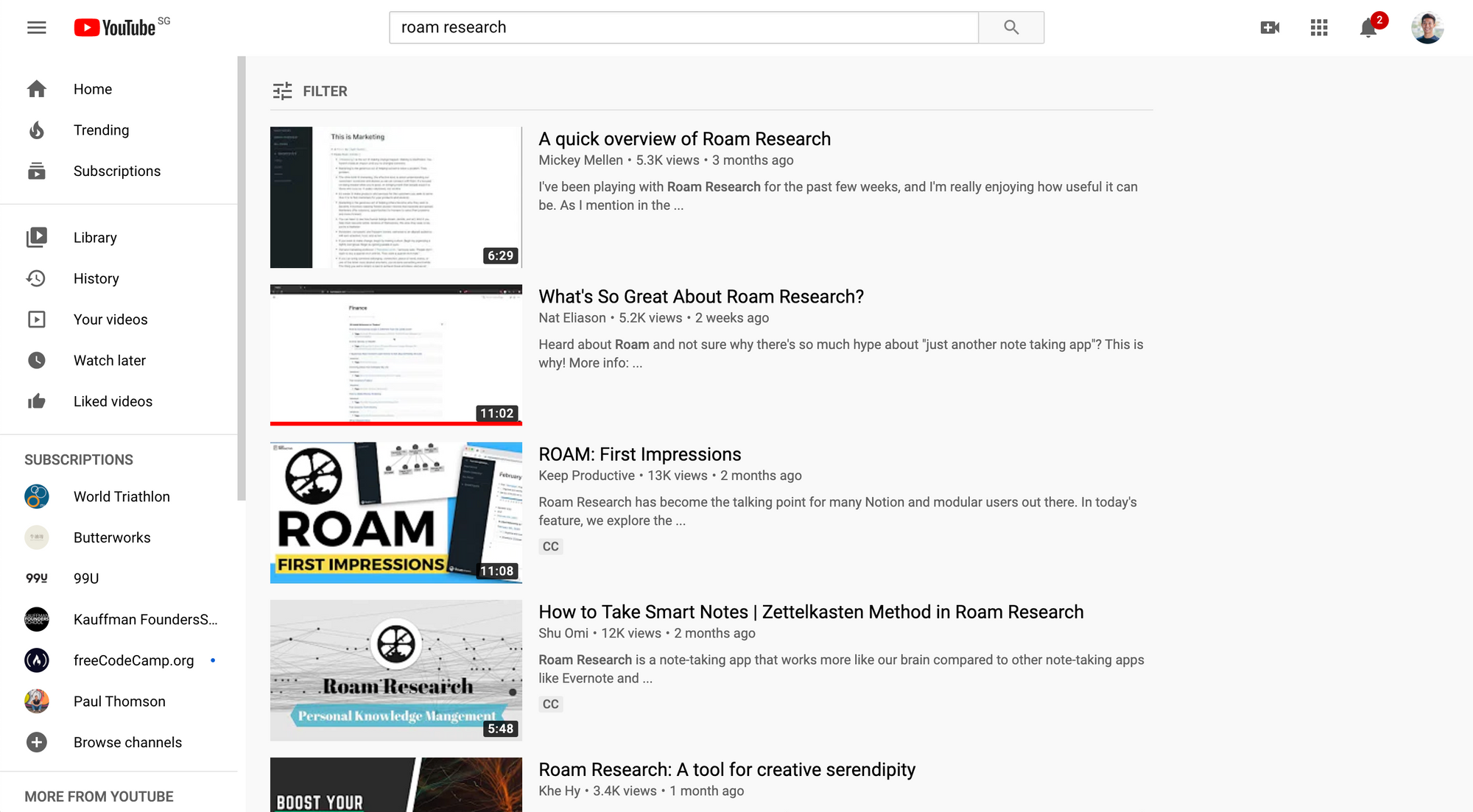 Their Slack community has just over 1,000 participants, actively sharing tips and videos they have made about Roam.
Their Slack community has just over 1,000 participants, actively sharing tips and videos they have made about Roam.
Their subreddit, started four months ago, has 1,700 members who post and comment several times every day.
On Twitter, Roam users started using #RoamCult.
If you think about it, these are things that a tech company would hire a team of marketers to do. I know we did at Buffer. Courses, blog, videos, community. Roam users are doing all these voluntarily. This is a great sign that Roam would grow very quickly.
Also, look at the hockey stick growth of domains linking to Roam's website.
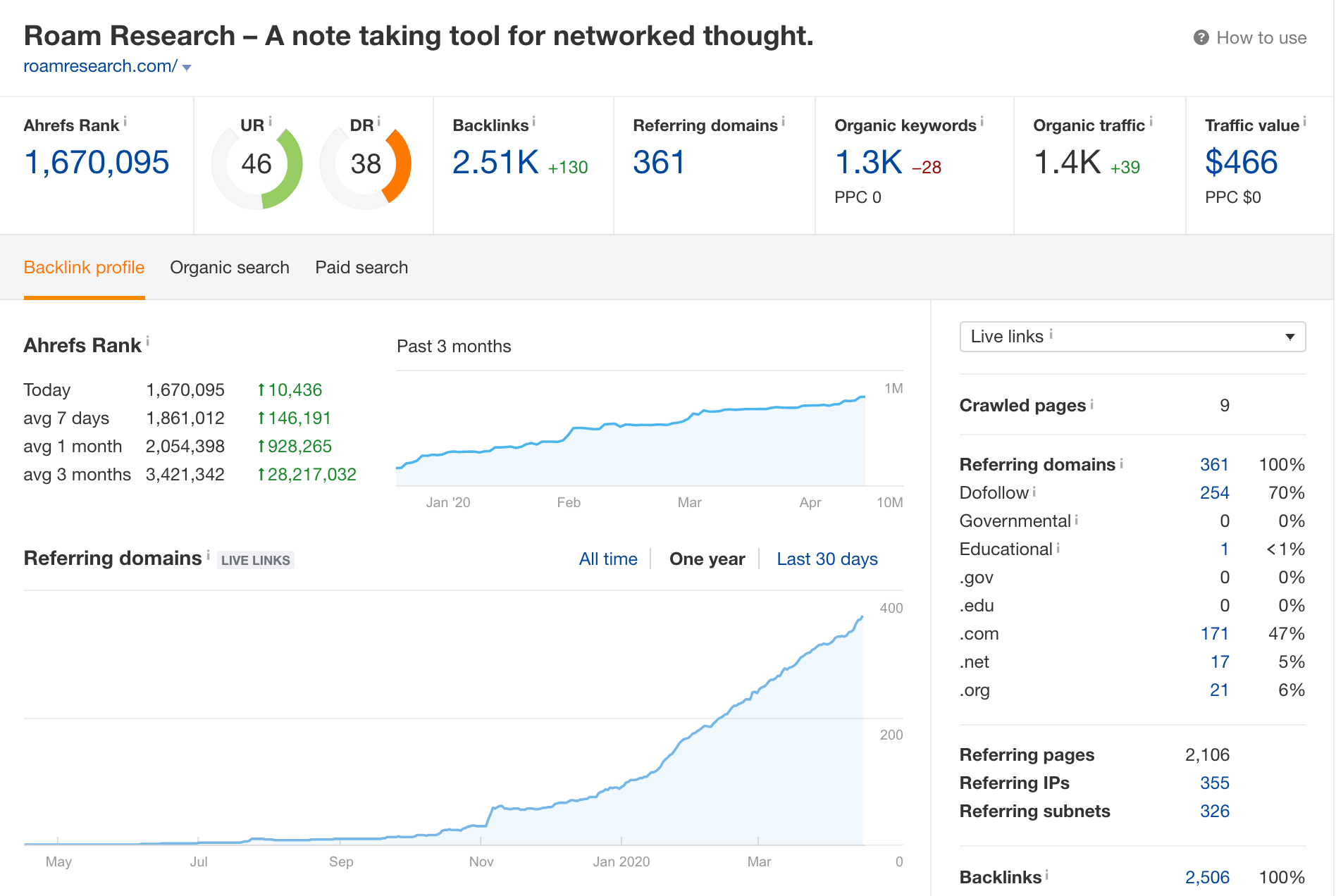
Steep learning curve as the key driver of growth
My guess is it takes about 5 hour investment of time for @RoamResearch to REALLY click.
— Conor White-Sullivan, Co-founder of Roam Research
Five hours?!
Most growth marketers will tell you that's too long. But it is working for Roam. Why is that so?
The steep learning curve is interestingly the main reason for its early growth.
If you didn't get the sense yet, I should first mention Roam is a great tool. Good marketing can grow a great product quickly but even great marketing can't rescue a bad product.
Because Roam is a powerful note-taking/knowledge management/CRM tool and it seems really hard to use, once people learn how to use it, they want to keep talking about it. It makes them look smart, especially when many people still haven't figure out how to use Roam. It's like how teenagers love to use and talk about Snapchat and TikTok because older people, like me, don't understand it. (But here I am, writing about Roam to look smart.)
That's why early Roam users have created so much content about it.
When multiple smart people are talking about Roam, it creates a halo effect. For example, several people I respect and follow on Twitter have been talking about Roam: Nat Eliason, Visakan Veerasamy, Jeff Morris Jr., Nathan Baschez, Erik Torenberg. I look up to Nat as a smart marketer and a smart person overall. He raved about Roam in a long essay and created the course. "If Nat is so smart and he recommends Roam, then Roam must be good," I kept thinking. Nat's blog post is the reason I kept going back to Roam after giving up and eventually decided to invest the time to learn it.
As Roam got the attention of investors, the word keeps spreading, perhaps even faster now.
The scarcity effect
Because Roam is a new product (just four-month old), it makes sense that they are adding new users slowly. It's a common approach for apps nowadays. Get a few users, ask them for feedback, improve your product, then get a few more users. When Roam first became available, researchers and academic writers got priority to use it.
If you try to sign up for Roam now, you'll see it is still in beta.
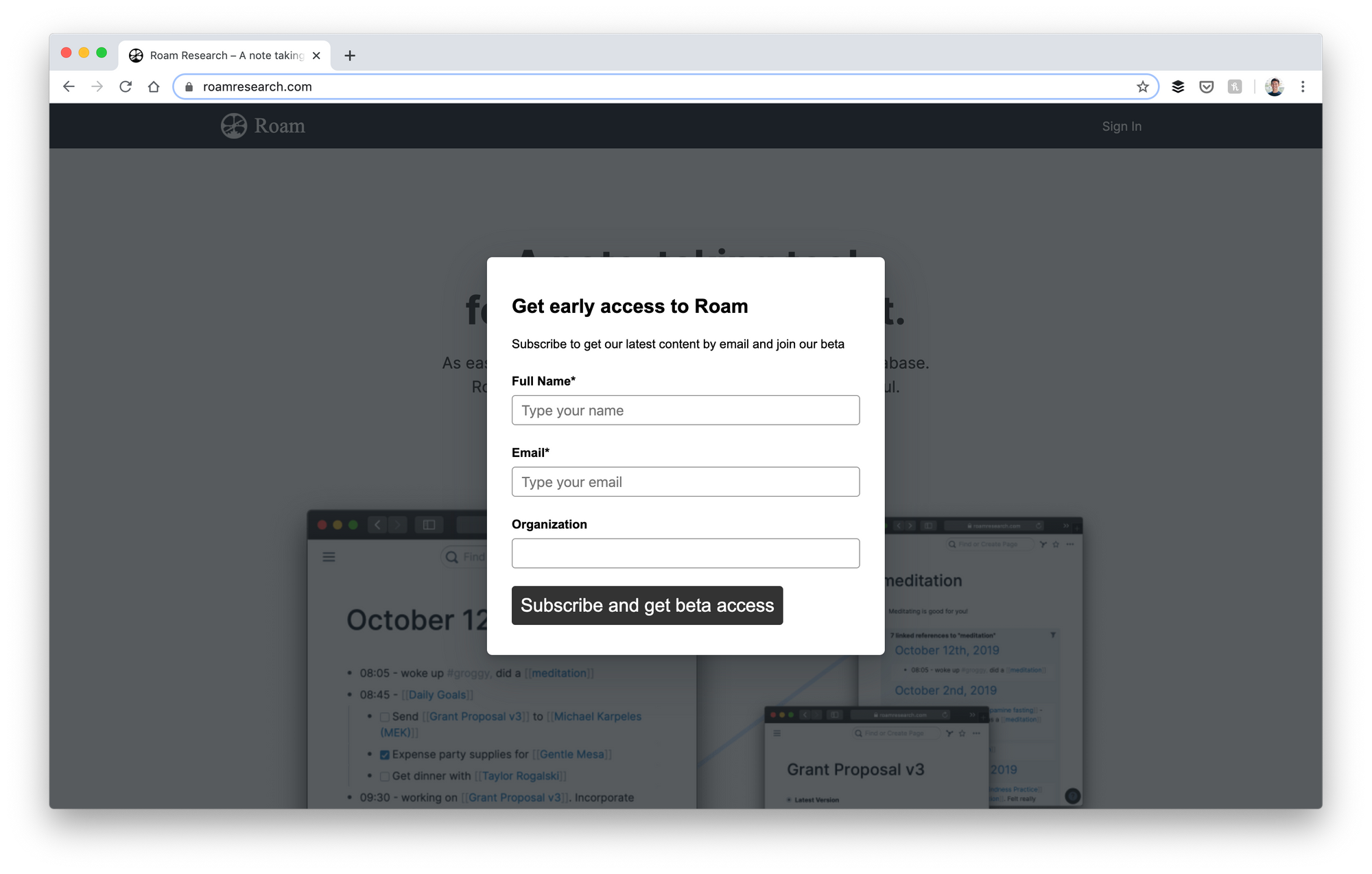 While Conor White-Sullivan, co-founder of Roam Research, might not have done this intentionally, the limited access has created a scarcity effect. When something is in low supply, people place higher value on it. When it is in abundance, people don't value it as much.
While Conor White-Sullivan, co-founder of Roam Research, might not have done this intentionally, the limited access has created a scarcity effect. When something is in low supply, people place higher value on it. When it is in abundance, people don't value it as much.
In the early days of Product Hunt, only people who are invited get access to it. Those who didn't have an invite started asking how to | get one. The answer by Ben Tossell, the then Community Manager at Product Hunt, received more than 1,500 views.
Dribbble is the same. Even until today, only users with an invite can post their work on Dribbble. The other option is to pay for a Pro account.
Finding the next phase of growth
"Poor distribution—not product—is the number one cause of failure. If you can get even a single distribution channel to work, you have great business. If you try for several but don’t nail one, you’re finished."
— Peter Thiel, Co-founder of PayPal, Palantir Technologies, and Founders Fund
The key to the next phase of growth for Roam is to funnel the enthusiasm of its community into SEO.
SEO will be the strongest channel for Roam because Roam has multiple use cases with high search demand, which will generate a ton of organic traffic. On top of that, its low price point will enable a self-serve approach, helping to convert much of the organic traffic.
Unlike other channels (e.g. paid advertising), SEO compounds over time. Users create content about Roam. Some content ranks well and attracts more users. A percentage of the new users create more content. And the cycle repeats. Every article and webpage created can have a lasting impact for years. At Buffer, we started content marketing in 2011. Over the last nine years, our organic search traffic has grown tremendously and we have been able to maintain it without much additional work. And our revenue have grown in tandem.
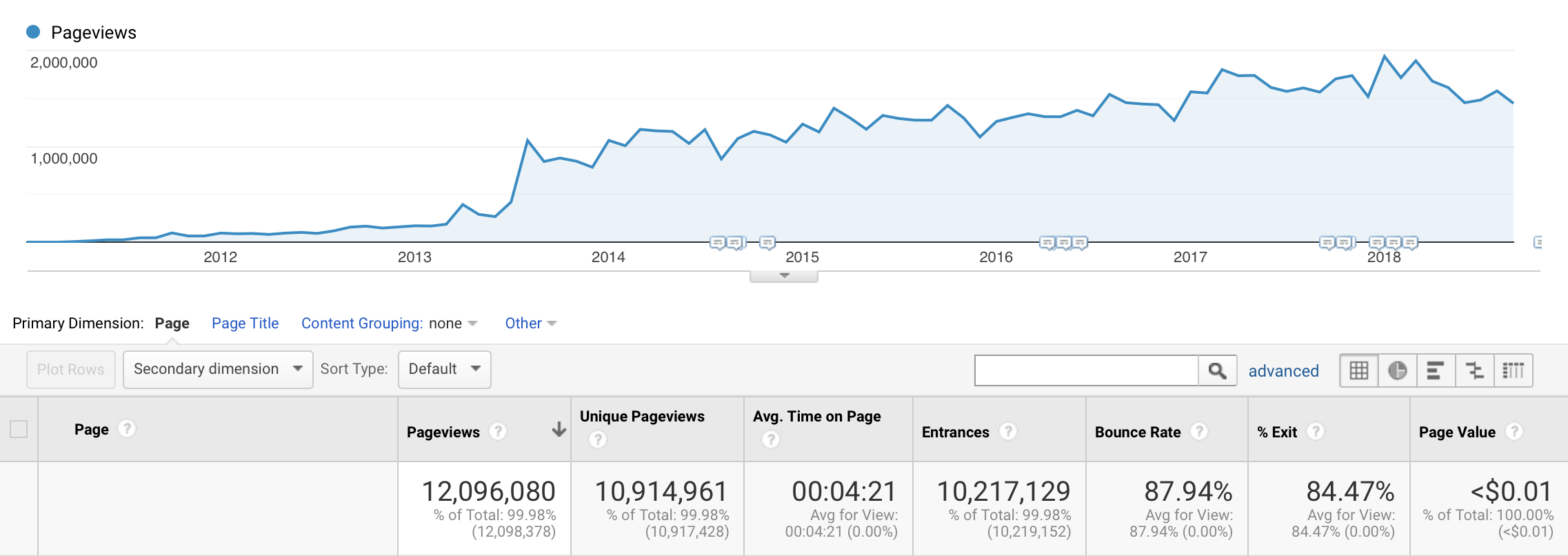 Buffer blog traffic before we moved it to a different domain
Because Roam has multiple use cases (journalling, productivity, studying, crm, etc.), it has the potential to rank for many high-search volume keywords. For example,
Buffer blog traffic before we moved it to a different domain
Because Roam has multiple use cases (journalling, productivity, studying, crm, etc.), it has the potential to rank for many high-search volume keywords. For example, thinking, productivity, and studying have relatively high search volumes with low keyword difficulties.

thinking might be the best place to start because it matches Roam's main use case, has a low keyword difficulty, and is a topic that individuals (Roam's current target audience) would search for. productivity and studying might also be great ones to work on.
(crm has a huge search volume but I wouldn't want to compete with Salesforce and HubSpot in that space at the start. While knowledge management has a low keyword difficulty and high commercial value, it seems to be a term searched by people managing organizations, which isn't Roam's target audience at least for now.)
The goal is to rank for these head terms by building topic clusters around each of them as soon as possible. The sub-topics and sub-sub-topics will tackle long(er)-tail keywords with lower competition.
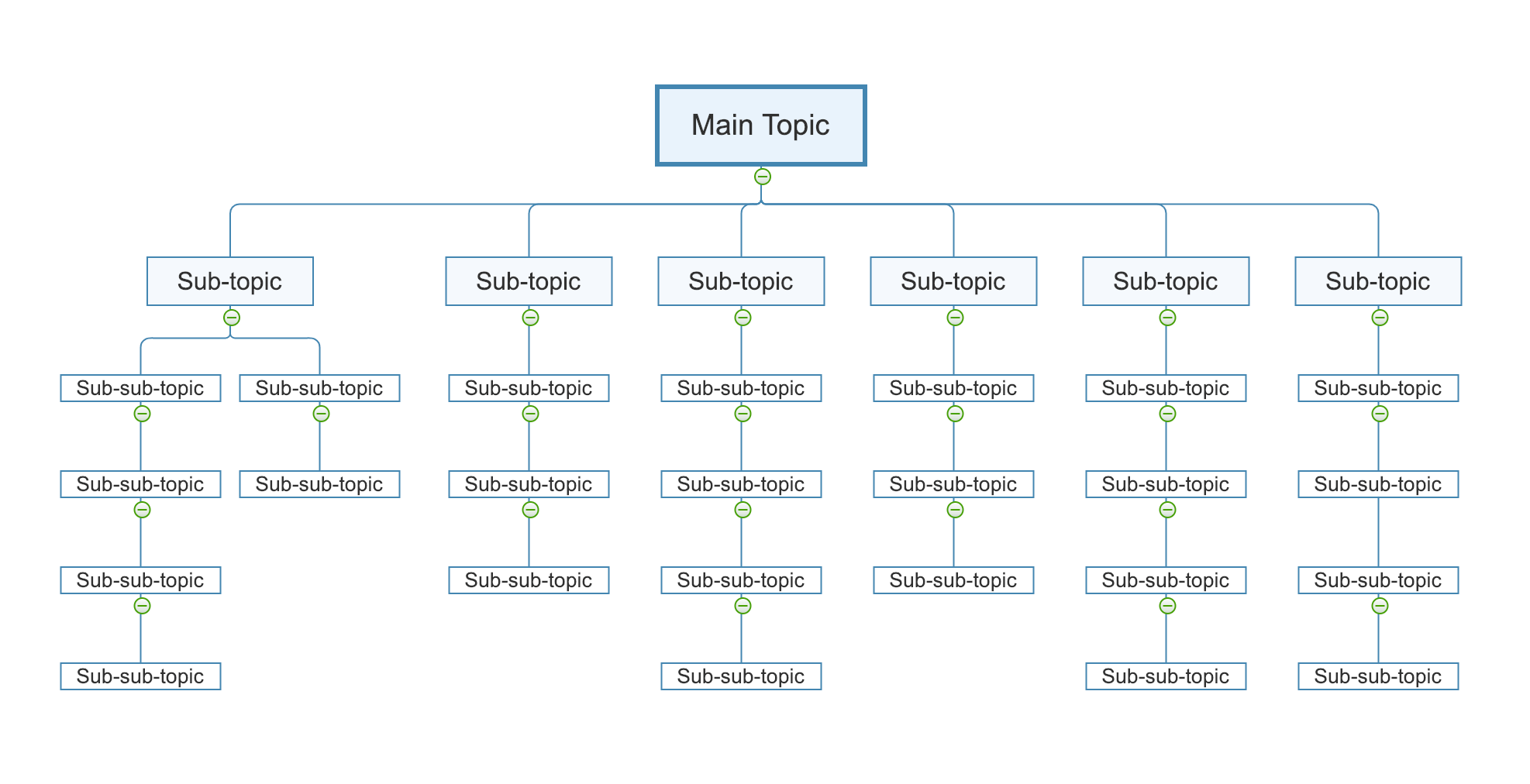 Using Ahrefs, I found a few relevant topics that might be worth exploring further:
Using Ahrefs, I found a few relevant topics that might be worth exploring further: critical thinking, divergent thinking, lateral thinking, systems thinking. The best part is that Roam is a tool that people could use in these areas. The idea, of course, is not to sell Roam in the content but to teach people how they could use Roam for those things. This would also make sense for Roam because it has a steep learning curve. Such education content will help ensure users succeed in using it and continue paying for it.
Low keyword difficulty, reasonable search volume and clicks, and high business relevance. Perfect!
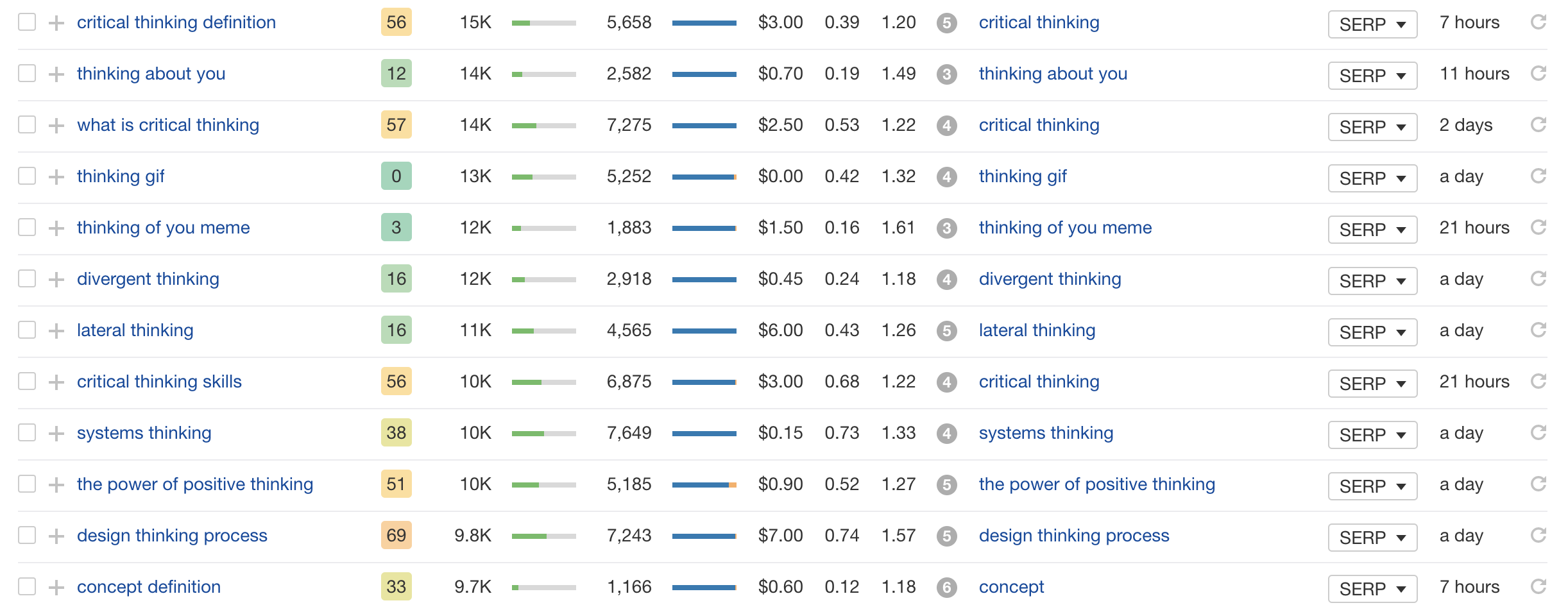 To get organic search traffic is harder than ever now because almost every company is creating content to rank on Google or spending money to place their websites above organic search results.
To get organic search traffic is harder than ever now because almost every company is creating content to rank on Google or spending money to place their websites above organic search results.
Also, popular note-taking tools such as Evernote and Notion will likely compete for quite a bit of the search traffic. As seen from Ahrefs, they have much higher Domain Rating (DR) than Roam.
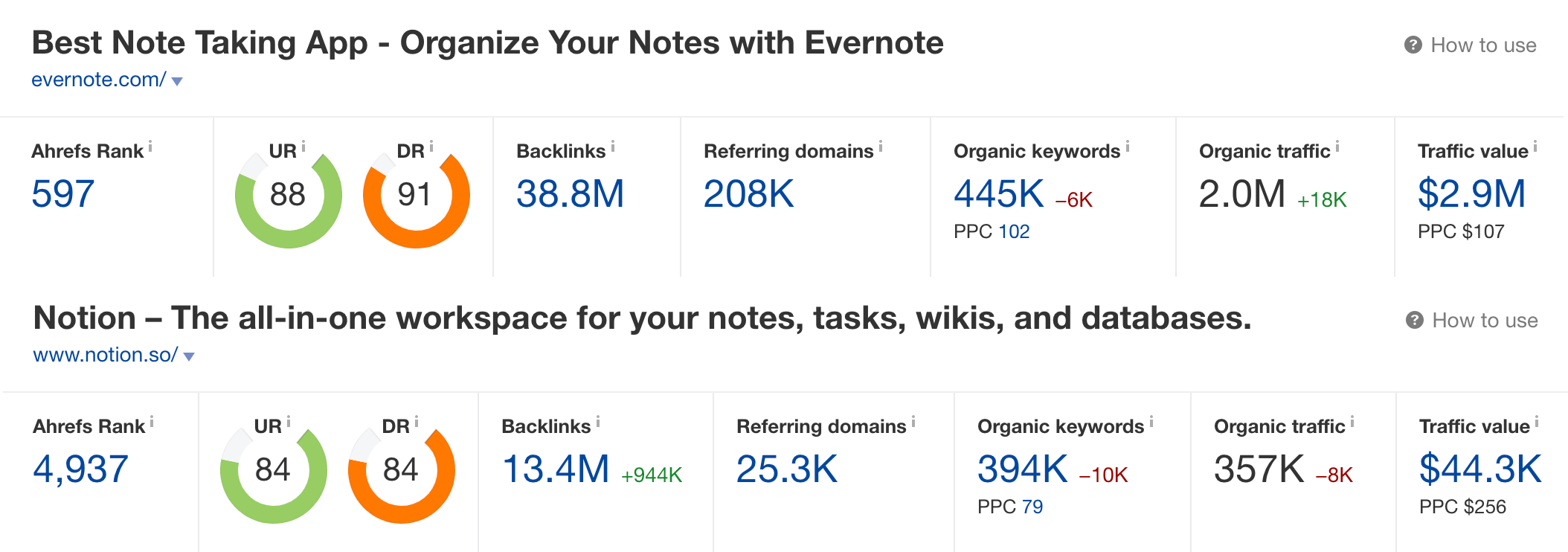 But Roam has a unique advantage: its cult.
But Roam has a unique advantage: its cult.
The community has already created hundreds of articles and videos about Roam and is linking to https://roamresearch.com/. As we have seen in the Ahrefs' screenshot above, Roam's backlink profile is already growing at an incredible pace. If Roam is able to continue engaging its community and helping them create more content, I don't think it'll be an issue to rank for some of the more competitive keywords.
Once Roam starts seeing diminishing marginal returns from SEO, it can begin exploring other channels while knowing it has a solid foundation in place.
As a heavy-user of Roam (and maybe investor because I invest my information in it), I can't wait to see Roam thrive and grow even further. All the best to the team!